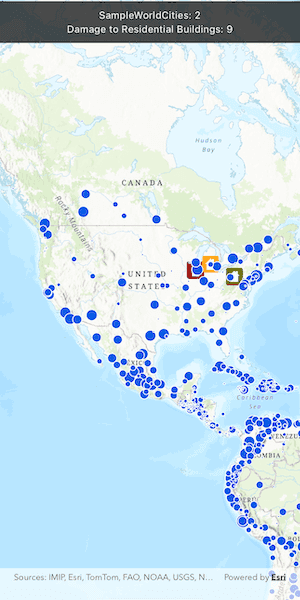Identify features in all layers in a map.

Use case
This sample allows users to tap on a map, returning features at that location across multiple layers. Because some layer types have sublayers, the sample recursively counts results for sublayers within each layer.
How to use the sample
Tap to identify features. A banner will list layers with features under the tapped location, as well as a layer count.
How it works
- The tapped position is passed to
ArcGISMapViewController.identifyLayers. - For each
IdentifyLayerResultin the results, features are counted.
Note: there is one identify result per layer with matching features; if the feature count is 0, that means a sublayer contains the matching features.
Relevant API
- ArcGISMapViewController.identifyLayers
- IdentifyLayerResult
- IdentifyLayerResult.layerContent.name
- IdentifyLayerResult.sublayerResults
Additional information
The GeoViewController supports two methods of identify: identifyLayer(), which identifies features within a specific layer, and identifyLayers(), which identifies features for all layers in the current view.
Tags
identify, recursion, recursive, sublayers
Sample Code
//
// Copyright 2024 Esri
//
// Licensed under the Apache License, Version 2.0 (the "License");
// you may not use this file except in compliance with the License.
// You may obtain a copy of the License at
//
// https://www.apache.org/licenses/LICENSE-2.0
//
// Unless required by applicable law or agreed to in writing, software
// distributed under the License is distributed on an "AS IS" BASIS,
// WITHOUT WARRANTIES OR CONDITIONS OF ANY KIND, either express or implied.
// See the License for the specific language governing permissions and
// limitations under the License.
//
import 'package:arcgis_maps/arcgis_maps.dart';
import 'package:arcgis_maps_sdk_flutter_samples/common/common.dart';
import 'package:flutter/material.dart';
class IdentifyLayerFeatures extends StatefulWidget {
const IdentifyLayerFeatures({super.key});
@override
State<IdentifyLayerFeatures> createState() => _IdentifyLayerFeaturesState();
}
class _IdentifyLayerFeaturesState extends State<IdentifyLayerFeatures>
with SampleStateSupport {
// Create a controller for the map view.
final _mapViewController = ArcGISMapView.createController();
// A flag for when the map view is ready and controls can be used.
var _ready = false;
// The message to display in the result banner.
var _message = '';
@override
Widget build(BuildContext context) {
return Scaffold(
body: Stack(
children: [
// Add a map view to the widget tree and set a controller.
ArcGISMapView(
controllerProvider: () => _mapViewController,
onMapViewReady: onMapViewReady,
onTap: onTap,
),
// Add a banner to show the results of the identify operation.
SafeArea(
child: IgnorePointer(
child: Visibility(
visible: _message.isNotEmpty,
child: Container(
padding: const EdgeInsets.all(10),
color: Colors.black.withValues(alpha: 0.7),
child: Row(
mainAxisAlignment: MainAxisAlignment.center,
children: [
Text(
_message,
textAlign: TextAlign.center,
style: Theme.of(context).textTheme.customWhiteStyle,
),
],
),
),
),
),
),
// Display a progress indicator and prevent interaction until state is ready.
LoadingIndicator(visible: !_ready),
],
),
);
}
Future<void> onMapViewReady() async {
// Create a feature layer of damaged property data.
final serviceFeatureTable = ServiceFeatureTable.withUri(
Uri.parse(
'https://sampleserver6.arcgisonline.com/arcgis/rest/services/DamageAssessment/FeatureServer/0',
),
);
final featureLayer = FeatureLayer.withFeatureTable(serviceFeatureTable);
// Create a layer with world cities data.
final mapImageLayer = ArcGISMapImageLayer.withUri(
Uri.parse(
'https://sampleserver6.arcgisonline.com/arcgis/rest/services/SampleWorldCities/MapServer',
),
);
await mapImageLayer.load();
// Hide continent and world layers.
mapImageLayer.subLayerContents[1].isVisible = false;
mapImageLayer.subLayerContents[2].isVisible = false;
// Create a map with a basemap style and an initial viewpoint.
final map = ArcGISMap.withBasemapStyle(BasemapStyle.arcGISTopographic);
map.initialViewpoint = Viewpoint.fromCenter(
ArcGISPoint(
x: -10977012.785807,
y: 4514257.550369,
spatialReference: SpatialReference.webMercator,
),
scale: 68015210,
);
// Add the layers to the map.
map.operationalLayers.addAll([featureLayer, mapImageLayer]);
// Add the map to the map view.
_mapViewController.arcGISMap = map;
// Set the ready state variable to true to enable the sample UI.
setState(() {
_message = 'Tap on the map to identify layer features.';
_ready = true;
});
}
Future<void> onTap(Offset localPosition) async {
// Identify features at the tapped location.
final identifyLayerResults = await _mapViewController.identifyLayers(
screenPoint: localPosition,
tolerance: 12,
maximumResultsPerLayer: 10,
);
// Count the number of identified features.
var identifyTotal = 0;
final layerCounts = <String>[];
for (final result in identifyLayerResults) {
final layerTotal = result.totalCount;
identifyTotal += layerTotal;
layerCounts.add('${result.layerContent.name}: $layerTotal');
}
// Display the results in the banner.
setState(() {
_message = identifyTotal == 0
? 'No features identified.'
: layerCounts.join('\n');
});
}
}
extension on IdentifyLayerResult {
// The total count of features, recursively including all sublayers.
int get totalCount {
return sublayerResults.fold(
geoElements.length,
(previous, element) => previous + element.totalCount,
);
}
}